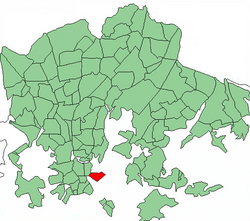Katajanokka
|
Katajanokka Skatudden |
|
|---|---|
| Helsinki Subdivision | |
 Position of Katajanokka within Helsinki |
|
| Country |
|
| Region | Uusimaa |
| Sub-region | Greater Helsinki |
| Municipality | Helsinki |
| Subdivision number | 08 |
| District | Southern |
| Subdivision regions | none |
| Area | 0.57 km2 (0.22 sq mi) |
| Population (2005) | 4,167 |
| • Density | 7,244/km2 (18,760/sq mi) |
| Postal codes | 00160 |
| Neighbouring subdivisions |
Kruununhaka Kaartinkaupunki |
Katajanokka (Swedish: Skatudden) is a neighbourhood of Helsinki, Finland, with around 4000 inhabitants in 2005. The district is located adjacent to the immediate downtown area, though in the first major town plan for Helsinki from the mid-18th century, the area fell outside the fortifications planned to encircle the city. Originally, it was a headland of the Helsinki peninsula but is now technically an island, as a small canal was dug across the base of the headland in the 19th century. Katajanokka is one of the most distinguished neighbourhoods in Helsinki. Katajanokka's residents include former Finnish President (from 1982 to 1994) Mauno Koivisto and composer Einojuhani Rautavaara.
The south side of Katajanokka is dominated by a passenger harbour which is frequented by large cruiseferries traveling between Helsinki, , Mariehamn, Tallinn and . The rest of the district comprises co-operative apartment buildings and several small parks. The western part of the residential area, known as the "Old Side" of Katajanokka, is an upscale neighborhood and a well-preserved example of early 20th century Art Nouveau architecture, though up until the mid-19th century – while the centre of Helsinki was being filled with stone buildings – the area was essentially still a wooden shanty town. The eastern part was for a long time a closed military area containing a naval base and shipyard, later a commercial shipyard. It was redeveloped in the 1970s and 1980s into a mainly residential zone, often referred to as the "New Side" of Katajanokka. The new residential area is considered an exceptional example of modern town planning. A major part of the project was the conversion and extension of the old Russian naval barracks to house the Finnish foreign ministry.
...
Wikipedia
